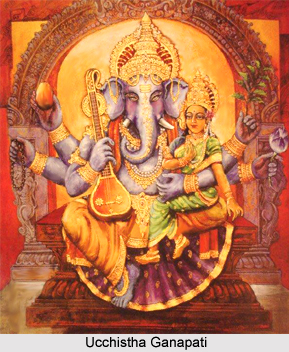 Ucchistha Ganapati is one of the thirty-two forms of Lord Ganesha. Ucchistha Ganapati is considered as the Lord of Superiority and the Lord of Blessed Offering. Lord Ganesha is the son of Lord Shiva and Goddess Parvati (Uma). In this incarnation, Lord Ganesha is depicted with a red complexion and six arms. He carries a pomegranate, beads of Rudraksha, a Veena (musical instrument), a blue lotus, His broken tusk and a sprig of paddy.
Ucchistha Ganapati is one of the thirty-two forms of Lord Ganesha. Ucchistha Ganapati is considered as the Lord of Superiority and the Lord of Blessed Offering. Lord Ganesha is the son of Lord Shiva and Goddess Parvati (Uma). In this incarnation, Lord Ganesha is depicted with a red complexion and six arms. He carries a pomegranate, beads of Rudraksha, a Veena (musical instrument), a blue lotus, His broken tusk and a sprig of paddy.
Ucchistha Ganapati is seated in Padmadsana (lotus position in yoga) along with another Goddess (Shakti). Some of the legends mentioned in the Mahapuranas and the Upapuranas describe Ucchistha Ganapati with a blue complexion. Devotees worship this form of Lord Ganesha to achieve success in new ventures, advancements in work and to attain predominance in life. Some of the popular temples of the Ucchhishta Ganapati form of Ganesha are Rockfort Ucchi Pillayar Temple in Thiruchirapalli, Tamil Nadu; Maha Ganapathi Temple in Thiruvananthapuram in Kerala; and Nanjangud and Chamarajanagar in Mysore, Karnataka.
Ucchistha Ganapati can be worshipped during any time of the day. There are no rules related to the worship of the Hindu deity. This form of Ganesha is worshipped with the Ucchistha Ganapati Mantra which is recited by the devotees for sixteen thousand times. The devotional hymn is mentioned below-
Sankalpa
Asyashree Uchista Ganesh Mantrasya
Sughora Rishihi Nibhida Gayathree Chandhaha
Ucchista Ganapathirdhevata Mama
Sarvabheesta Sidhyarthe Jape Viniyogaha
Anganyasa
Om Sughora Rishaye Namaha - Shirasi
Om Nibhida Gayathree Chandhase Namaha - Mukhe
Om Ucchista Ganapathaye Namaha - Hrudhaye
Viniyogaya Namaha - Sarvange
Karanyasa
Om Angustabhyam Namaha
Om Tharjaneebhyam Swaha
Om Madhyamabhyam Vashat
Om Anamikabhyam Hoom
Om Karathalakara Prastabhyam Phat
Hrudhayadhinyasa
Om Hrudhayaya Namaha
Om Shirase Swaha Om Shikhayai Vashat
Om Kavachaya Hum Om Nethrathrayaya Vaushat
Om Asthraya Phat
Dhyana
Rakthamoorthim Ganeshancha Sarvabharana Bhooshitham
Rakthavasthram Threenethram Cha Rakthapadmasane Sthitham
Chaturbhujam Mahakayam Dhvidantam Susmithananam
Istancha Dakshinehasthe Dantham Cha Dhadhathaha Kare
Pashankushou Cha Hasthabhyam Jatamandala Vestitham
Lalate Chandrarekhadyam Sarvalankara Bhooshitam
Mantra of Ucchistha Ganapati
* Om Hasthi Pishachi Likhe Swaha
* Om Gam Hasthi Pishachi Likhe Swaha
* Om Namo Bhagavate Ekadhamstraya Hasthimukhaya Lambodharaya Ucchistamahathmane Aam Krom Hreem Gam Ghe Ghe Swaha




















